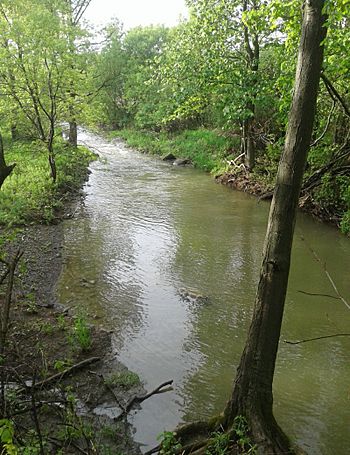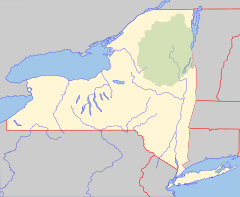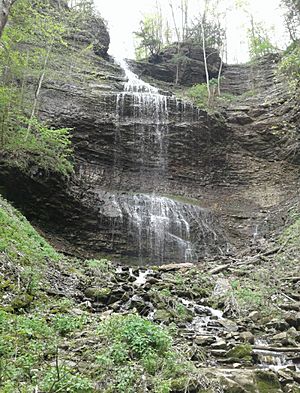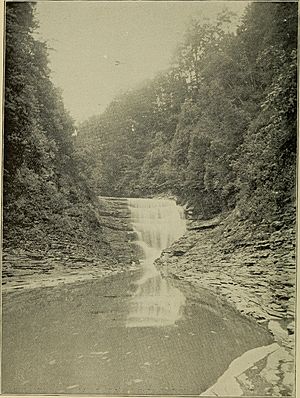Canajoharie Creek facts for kids
Quick facts for kids Canajoharie Creek |
|
|---|---|

Canajoharie Creek by Mill Road southwest of the hamlet of Sprout Brook
|
|
|
Location of the mouth within New York
|
|
| Country | United States |
| State | New York |
| Region | Central New York Region |
| Counties | Otsego, Montgomery |
| Towns | Cherry Valley, Canajoharie |
| Physical characteristics | |
| Main source | N of Cherry Valley, New York 42°48′38″N 74°44′34″W / 42.81056°N 74.74278°W |
| River mouth | Mohawk River Canajoharie, New York 285 ft (87 m) 42°54′32″N 74°34′11″W / 42.90889°N 74.56972°W |
| Basin features | |
| Basin size | 69.22 sq mi (179.3 km2) |
| Tributaries |
|
| Waterfalls | Judds Falls, Canajoharie Falls |
The Canajoharie Creek is a river in New York State. It flows into the Mohawk River in the village of Canajoharie. The name "Canajoharie" comes from the Mohawk language. It means "the pot that washes itself." This name refers to a special spot in the creek. It's a large pothole called the "Canajoharie Boiling Pot." This pot is about 20-foot (6.1 m) wide and 10-foot (3.0 m) deep.
Two main streams flow into Canajoharie Creek. One is Bowmans Creek, which joins east of Sprout Brook. The other is Brimstone Creek, which joins north of Ames.
Contents
The Creek's Journey: Where Canajoharie Creek Flows
Starting Point to Brimstone Creek
Canajoharie Creek starts in a forest north of Cherry Valley. It begins its journey by flowing north. Soon, it goes under U.S. Route 20. After that, it reaches its first waterfall, Judds Falls. This waterfall is also known as Tekaharawa Falls.
The creek keeps flowing north for a short distance. Then, it turns east and flows next to Van Derwerker Road. It crosses under Mill Road. After that, it flows alongside Mill Road for a bit. It then crosses under Cherry Valley Road, Otsego Road, and Vandeusenville Road. Soon after, it meets Bowmans Creek. This meeting point is east of Sprout Brook.
After Bowmans Creek joins, Canajoharie Creek flows next to State Route 163. It crosses under Vandeusenville Road again. The creek continues east, passing south of Buel. It then crosses under South Buel Road and Macphall Road. After Macphall Road, the creek turns north briefly. It crosses under West Ames Road. Then, it turns back east. Finally, it meets Brimstone Creek north of Ames.
From Brimstone Creek to the Mohawk River
After Brimstone Creek joins, Canajoharie Creek crosses under State Route 10. It flows north of the village of Ames. The creek continues east, crossing under Shunk Road and Mapletown Road. It briefly curves north, then west, near Waterville.
After this short turn west, it heads north. It crosses Old Tavern Road. Then, it flows next to Maple Hill Road for a short distance. The creek then turns northwest. It meets State Route 10 again and flows alongside it. The creek passes east of Marshville. It also goes under Mc Ewan Road. Soon after, it curves east and flows next to Maple Hill.
About halfway along Maple Hill, the creek enters the Canajoharie Gorge. Here, it passes a place called Wintergreen Flats. About 1.5 miles (2.4 km) before its end, the creek flows over the 45-foot (14 m) Canajoharie Falls. The creek then flows through a narrow, deep canyon. Along the way, you can see the deep pothole known as "the boiling pot." After this, the creek flows through the Village of Canajoharie. It goes under State Route 5S. Finally, it joins the Mohawk River.
History of Canajoharie Creek
The first European settlers arrived along the creek around 1730. These were Hendrick Schrembling and Marte Janse Van Alstyne. They settled in what is now the village of Canajoharie. In 1750, Schrembling sold his land to Van Alstyne. Schrembling stayed in the area. He ran a tavern, a store, and a grist mill (a mill for grinding grain). He moved away after the American Revolution. In 1772, Colonel Hendrick Frey built a mill and a house by the creek.
Johannes Roof arrived in 1778. He bought Schrembling's properties and kept running the inn. On the east side of the creek, you can find a house built around 1775. It was built by Gose Van Alstyne, Marte Janse Van Alstyne's son. This house was made stronger around 1780. It was first called Fort Van Rensselaer, then later Fort Washington.
In early times, roads followed the creek. These roads led to villages like Sharon Springs and Cherry Valley. One road went to Otsego Lake. It split off at the village of Ames. This road to Otsego Lake was used by General James Clinton's American army in 1779. The army set up camps along the creek in Buel and Sprout Brook. The troops reached Otsego Lake between July 2 and 4, 1779. Parts of this old road are now called Clinton's Road or Continental Road.
Sometimes, people have needed rescuing from the creek. This happens near Wintergreen Park because of flash flooding. In July 2017, 13 people were caught in a flash flood. They were rescued from the creek near some pools by the village of Canajoharie. In April 2019, heavy storms caused high water. This led to a wall collapsing in the village of Canajoharie.
What Does "Canajoharie" Mean?
The name "Canajoharie" comes from the Mohawk language. It means "the pot that washes itself." This refers to a special spot in the creek. It's a large pothole called the "Canajoharie Boiling Pot." This pothole is about 20 feet (6.1 m) wide and 10 feet (3.0 m) deep. Over thousands of years, water and pebbles wore away the rock to form this pot.
In the 1700s, the Mohawk people lived in the Mohawk Valley. This area included the land around Canajoharie Creek. The Mohawk were part of the Iroquois Confederacy. Their land stretched far and wide. It went north to the St. Lawrence River. It reached south into New Jersey and Pennsylvania. To the east, it touched the Green Mountains of Vermont. To the west, it bordered the land of the Oneida Nation.
The Creek's Geology: How the Land Was Formed
Like other gorges and ravines, the Canajoharie Gorge was shaped by erosion. Erosion is when water, wind, or ice slowly wear away rock and soil. The giant pothole, "the boiling pot," was formed by rocks rubbing against the limestone bedrock.
The rocks in the creek bed are mostly dolostone. This rock belongs to the Beekmantown Group. Some parts of the creek bed have limestone mixed with shale. These rocks are from the Trenton Group. They were formed during the Ordovician period, about 448-458 million years ago.
Some areas are covered by Utica Shale. This shale can be about 1,000 feet (300 m) thick in some places. At Wintergreen Park, the Utica Shale is black and thin. It contains bentonite, which is a type of clay. Bentonite forms from volcanic ash. This shows that volcanic ash once fell in or near this area. Between Wintergreen Park and the creek's mouth, you can find fossils. These fossils include trilobites, brachiopods, and graptolites.
Water Flow and Quality
The United States Geological Survey (USGS) keeps an eye on Canajoharie Creek. They have two special tools called stream gauges. These tools measure how much water is flowing. The upper gauge is near Mc Ewan Road. The lower one is at the creek's mouth.
The upper station recorded its highest water flow on August 28, 2011. This was when Hurricane Irene passed through. The water flow was 5,850 cubic feet (166 m3) per second. The lowest flow was on September 10, 2015. It was only .23 cubic feet (0.0065 m3) per second. The highest water temperature recorded was 99 °F (37 °C) on July 15, 1995.
The DEC checks the water quality of Canajoharie Creek. They rate it as Class C. This means the water is good for fishing. It's also safe for fun activities where you don't touch the water, like boating.
Fishing in Canajoharie Creek
If you like fishing, Canajoharie Creek is a good spot! In spring 2019, the DEC added many brown trout to the creek. They stocked 1330 trout that were 8 to 9 inches (20 to 23 cm) long. They also added 100 larger trout, about 12 to 15 inches (30 to 38 cm) long. Besides trout, you might also find carp in the creek.







